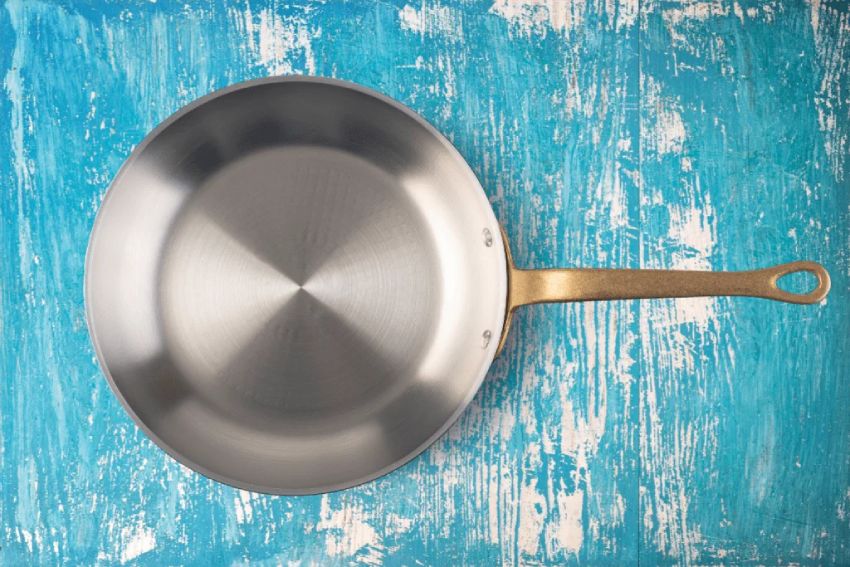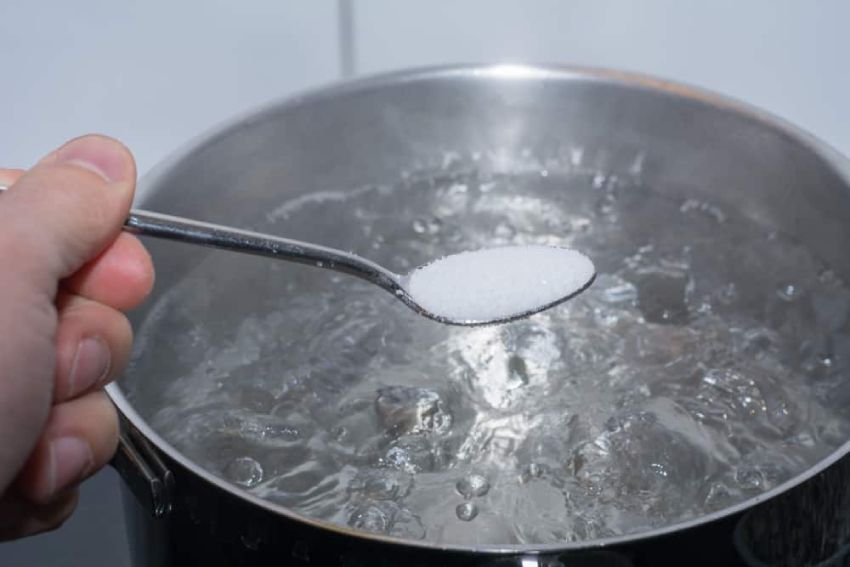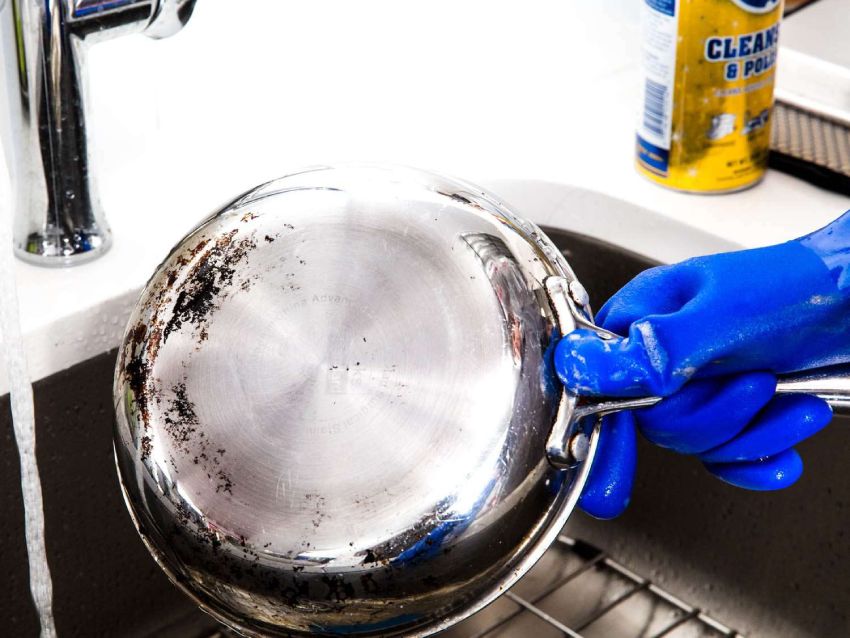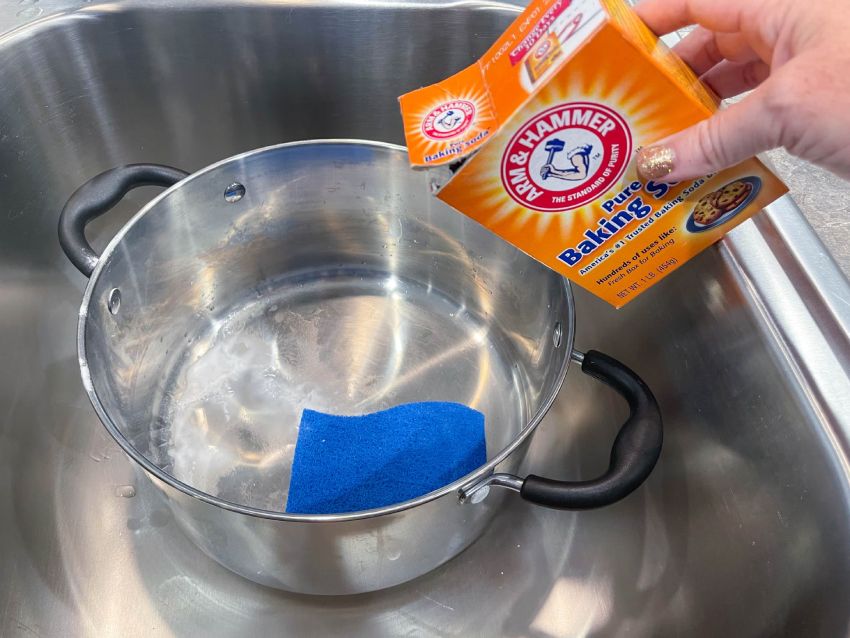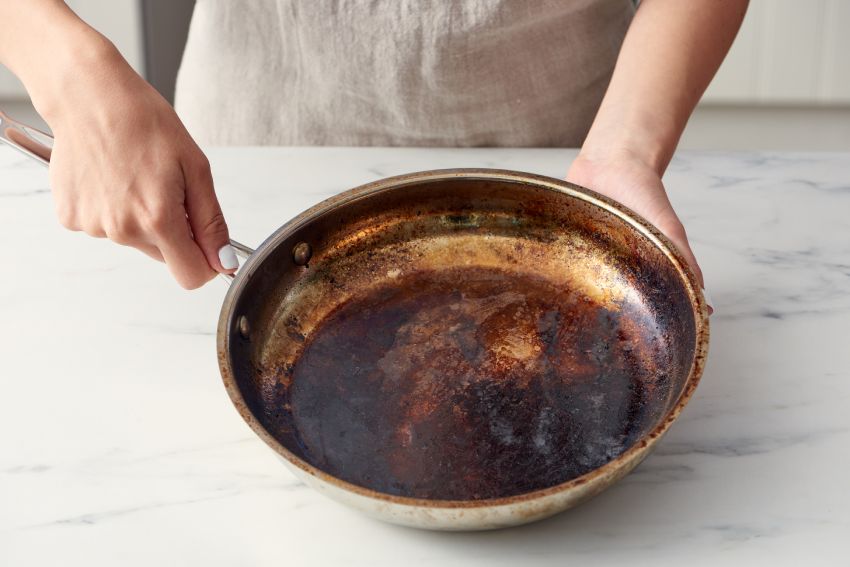Stainless steel pans often feel like a double-edged sword. You don’t have to worry about toxins leaching into your food but cleaning the pans can be rather tricky. You don’t want to scratch them up, yet the grease and food seem to stick way too well. It’s frustrating after trying to soak them for hours, and nothing is budging!
Rest assured, after much trial and error, we have found the easiest ways on how to clean the bottom of stainless steel pans. Let’s not wait to get started.
How Do You Make Stainless Steel Cookware Look New Again?
The burning question is how to keep your stainless steel pans sparkling. Well, there are two approaches. You can do a quick clean, or you can really go after these pesky stains. To make your pans look new, again, you will want to start with a deep clean.
Here is your step-by-step process.
- Get Your Materials
- Boil The Water
- Create the Mixture
- Submerge
- Scrub A Dub
Let’s get into the details.
Get Your Materials
So, how do you remove burnt-on food from stainless steel pans? You go right into a deep clean. This is the most time-consuming option out of the next few recommendations. But it’s worth the investment. Expect this process to take about 30 minutes to an hour of your time.
For this process, you will need:
- Baking soda
- A large tin that can handle boiling water and is big enough for a submerged pan
- Silicone gloves that cover forearms
- A scrubber or sponge
It’s important that all your materials are resistant to boiling water. This is what helps remove the burnt material It also is the way easiest way how to clean stainless steel pans with baking soda
1. Boil Water
You can boil the water directly in the tins or pan that you are using, or you need to boil in separate pans and pour it over, that’s OK. Just ensure that you have enough water to have the stainless steel pan completely submerged underwater to ensure all the burnt bits come off.
2. Create Your Mixture
For this process, you don’t need to combine a lot of potions and lotions. Simply grab a ½ cup of baking soda and pour it into the boiling water. Because baking soda is both mildly abrasive and alkaline, it helps reduce the acid in burnt foods that keep them stuck. In the simplest terms, it breaks it down.
3. Submerge Your Pan
Put the stainless steel into the water. It’s better if you keep the water at a mild boil but if there isn’t room on the stove, then let it sit in the hot water. It will still do the job. You can use tongs or gloves to rotate the pan as the water cools. This is not always necessary, but some people swear by it.
4. Scrub A Dub
If you want to know how you get burnt-on stainless steel off a pan. This is the step to do so. You may notice that some of the burnt scrapings have already come off and are floating. Once the water has cooled and is still warm, you can go in with a sponge and start scrubbing. Be careful not to use an abrasive sponge because this causes scratches in your stainless steel. The biggest culprit of this is steel wool. We will go over that in the latter part of the article.
What Is the Best Way to Clean a Stainless Steel Pan?
A deep clean is not always possible, so a basic cleaning often is a good way to get the job done. Baking soda is not the only approach either has many ask, “will vinegar damage stainless steel pans?” No. It’s actually a great combination with baking soda or on its own.
How to Clean Stainless Steel Pans with Vinegar
The process is similar to the above, except you can bring the boil straight inside your pan. Here is a quick substitute if you don’t have baking soda handy.
Get Your Materials
The Process
The process is simple and shouldn’t take more than 30 minutes to complete. You may have to judge how hot you need the water to be as you go.
- Take your bag and put it on top of the stove. If you have different-size burners, it’s better to opt for one of the bigger ones. A smaller burner will heat the middle of the pan less evenly than a larger one will.
- Pour the 3 cups of water into the pan and bring to a boil. Once the water is boiling, throw in ½ cup of vinegar. Let it sit and loosen up the burned materials inside the pan. You can leave for about 10 minutes.
- Stop the boil and let the water temperature cool before submerging your hands. If you are not using a sponge, you can use a scrubber that allows you to scrub while the burned material is loosening up.
- Take the handle (use an oven mitt), rinse the water down the sink, and see if any residue is left. You can run the warm water from the sink and try to get up any additional scraps. Everything should come off smoothly.
- Use a kitchen cloth to hand dry the stainless steel pan.
How to Clean Stainless Steel Pans with Vinegar and Baking Soda
While either work just fine on its own, you can use both to clean stainless steel pans. Since you will just need baking soda and vinegar, let’s get right to how to clean baked-on grease from stainless steel pan
- Mix together in a bowl of warm water 1 part baking soda to two parts vinegar. Pour the combination into the pan.
- Let the water sit in the pan for about 10 minutes before scrubbing. Then start scrubbing the pan with a non-abrasive sponge or scrubber.
- You may need to repeat the process a few times if the stains are sticking. You can also bring the water to a boil, but you must let it cool down like in the other processes to ensure safety.
The process is similar among most of the different solutions. Acidic combinations help break down the grease, which is why something like lemon juice also works.
Best Scrubber For Stainless Steel Pans
The one common theme here for cleaning your stainless steel pans is using a scrubber. This is better than using a sponge for a few different reasons. For starters, you don’t have to submerge your hands in the hot water. Also, the back of sponges can be too abrasive and scratch your stainless steel pans.
That’s why we have come up with a list of some of the best scrubbers you can use for stainless steel pans.
Regular Sponges over Steel Wool
Steel wool sponges are very common, and they are typically yellow sponges with green backing. This is made of small steel flexible fibers to help get off stuck-on food residue. It’s natural to want to use this kind of sponge, but this is exactly how you can scratch the surface of your stainless steel pans.
It’s better to use a sponge that does not use any abrasive surface at all. However, soft sponges are likely to deteriorate while you are washing the pan. This is why it’s not the best choice. However, if you are going to use one, ensure it is not steel wool.
Dish Brush With Handle
The best option is to use a dish brush with sturdy bristles that are not abrasive. The handle helps because you don’t have to worry about coming into contact with the hot water. However, you want to ensure the dish brush’s plastic isn’t subject to melting in hot water. While it is uncommon, some brushes may also have steel wool, which must be avoided.
Microfiber Cloths
The softest option is using a microfiber cloth. However, it is better for drying than it is for cleaning. It’s a sure way not to scratch your pan as it is soft. It’s better than having nothing, and sometimes working with your hands is the best approach.
It’s Worth Taking Your Time
Stubborn grease stains are a pain in the butt. However, they come off with a little tender love and care. It just may take a little more tenderness and care than love. There are a number of household items that get the job done. You want to use something that can break up the acid and loosen stuck-on stains. Vinegar and baking soda are the perfect pair for this job.
If you have the space to bring these materials to a boil with water, this is the fastest and easiest way to get anything up. But warm water will also do the trick. You may just need to rinse and repeat a few times before it looks new again.
